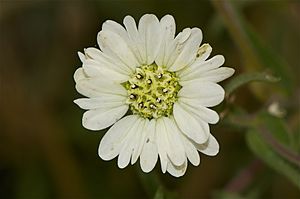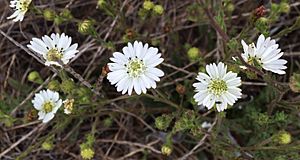Hayfield tarweed facts for kids
Quick facts for kids Hemizonia congesta |
|
|---|---|
 |
|
| Scientific classification | |
| Kingdom: | |
| (unranked): | |
| (unranked): | |
| (unranked): | |
| Order: | |
| Family: | |
| Subfamily: |
Asteroideae
|
| Tribe: | |
| Genus: | |
| Species: |
H. congesta
|
| Binomial name | |
| Hemizonia congesta |
|

Hemizonia congesta, often called hayfield tarweed, is a type of flowering plant. It belongs to the daisy family. You can find this plant growing naturally in western North America.
Contents
Where Does Hayfield Tarweed Grow?
Hayfield tarweed grows naturally in California and Oregon. It is a common plant in many places there. You will often see it in grasslands and open fields. This plant is native to the Central Valley (California) and the California Coast Ranges.
What Does Hayfield Tarweed Look Like?
Hemizonia congesta is an annual herb. This means it lives for only one growing season. It has thin, spindly stems that grow straight up. These stems can be from about 4 inches to 31 inches tall.
Plant Parts and Smell
Like other "tarweeds," this plant feels sticky. Its stems and leaves have glands that produce a sticky substance. This substance makes the plant smell a bit like tar. Most of its long, narrow, and pointy leaves are found lower down on the stem. They are below where the flower stalks branch out.
Flowers and Colors
The plant's inflorescences (flower clusters) are covered in sticky, glandular hairs. They hold flower heads that look like daisies. Each flower head has a center made of yellowish disc florets. These tiny flowers often have dark tips. Around the center, there is a fringe of bright yellow to white ray florets. These are the "petals" you see. The undersides of these ray florets often have purplish stripes. The tips of the ray florets are usually toothed or lobed. The middle tooth is often thinner than the others.
Different Types of Hayfield Tarweed
There are many different types of Hemizonia congesta. These are called subspecies. They can look a bit different from each other. Here are some of them:
- Hemizonia congesta subsp. calyculata — also known as Mendocino tarplant
- Hemizonia congesta subsp. clevelandii
- Hemizonia congesta subsp. congesta
- Hemizonia congesta subsp. leucocephala — also known as hayfield tarplant
- Hemizonia congesta subsp. luzulifolia
- Hemizonia congesta subsp. tracyi — also known as Tracy's tarplant

